Our view at Stack - Pipedrive is a robust CRM platform, offering automation, contact data collection, webhooks, AI-powered sales assistant, email communications, email marketing, and customisable sales pipeline workflows.
Convincing prospects your product will improve their life is a powerful and timeless sales skill.
Outcome-based selling is a tactic that will almost certainly boost your performance. You simply need to know how and when to apply it.
In this article, you’ll learn how to adopt an outcome-based selling strategy that wins you more business, increases customer loyalty and bolsters your company’s bottom line.
What is outcome-based selling?
Outcome-based selling (or outcome selling) is a sales strategy that involves promoting the results a customer will get from using your product instead of its features and specifications.
Focusing on outcomes like this makes your whole sales process more customer-centric and value-driven.
By shifting your sales conversations from “What does this product do?” to “What can this product do for you?”, you’ll better align your solutions with buyer goals and challenges.
As a result, prospective customers are more likely to convert, get lasting value from their investment and advocate for your brand.
What is a business outcome?
The “outcome” in outcome-based selling can mean any benefit a customer gets from your product, quantifiable or otherwise.
One common outcome is increased efficiency. Others include reduced risk, improved morale, higher revenue and streamlined operations.
An outcome-based selling example
Imagine a sales rep working for a project management software company.
Instead of highlighting the software’s many features like task tracking, collaboration tools and reporting dashboards, they focus on the outcomes the software delivers.
For example, they might say in a sales pitch:
Addressing the customer’s desire to unlock their team’s creativity and innovation while improving efficiency and productivity makes the pitch more compelling.
Recommended reading

Sales Methodology: How to Choose the Right One for Your Business
Why outcome-based selling is worth your time
Outcome-based selling requires a shift in mindset, especially if you’re used to pitching based on features and specifications, but it can significantly enhance your sales performance.
Here’s why outcomes always come first in sales.
Build more meaningful customer relationships
When focusing on business outcomes, aligning yourself with the customer’s success will help you build rapport and establish yourself as a partner rather than a vendor.
Loosening the buyer-seller dynamic like this puts you in a stronger position to sell since business-to-business (B2B) buyers typically trust industry peers more than vendors or salespeople.
Imagine you sell marketing automation software. Instead of listing features, you can discuss your customers’ specific marketing goals, such as increasing lead conversion rates or improving return on investment (ROI).
You can build a deeper, more meaningful relationship by showing an interest in your lead’s success and tailoring your solutions to meet their needs. The buyer is more likely to make repeat purchases (or stay subscribed) and refer others to your brand.
Become more customer-centric
The more you and your broader team practice outcome-based selling, the more you’ll learn about your customers’ needs and expectations. That knowledge is valuable across your business, not just the sales team.
When teams work together to share customer insights, all the following is possible:
-
Marketing teams know which qualities to highlight and how to present them in the most compelling ways, meaning they can generate higher-quality leads.
-
Customer support teams have more context for users’ tickets and inquiries to provide helpful information and offer better customer service.
-
Product development teams understand the most impactful features and improvements, leading to more relevant and successful product updates.
By centralizing customer information and interactions in a customer relationship management (CRM) tool, you’ll ensure teams have up-to-date insights on customer goals.
All departments can then work together to deliver those outcomes.
Recommended reading
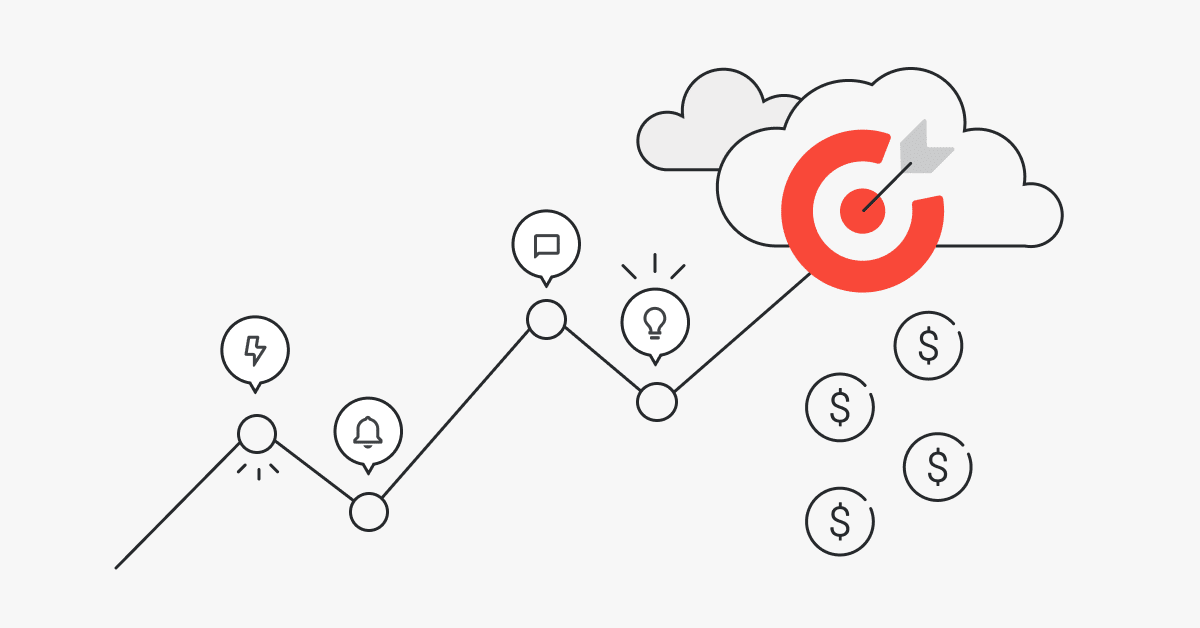
The Ultimate Guide to Activity-Based Selling: What, Why, and How
Close more high-value deals
Expected ROI significantly impacts buyer confidence. It means you can justify higher price points and close more lucrative deals by emphasizing realistic high-value outcomes.
Take artificial intelligence (AI), for example. Microsoft reports that businesses get an average return of $3.50 for every $1 they invest in AI, which explains why 93% of companies have justified the expense or plan to do so in the next 12 months. They’re confident of strong returns.

However, guaranteed ROI doesn’t exist, so you still need to support your claims. If you promise high-value outcomes and fail to deliver, you’ll lose business and damage your reputation.
Instead, tell satisfied customers’ stories in sales conversations and case studies so prospects have social proof to reassure them.
You can also encourage reviews that describe tangible outcomes, like this user review of Zapier:
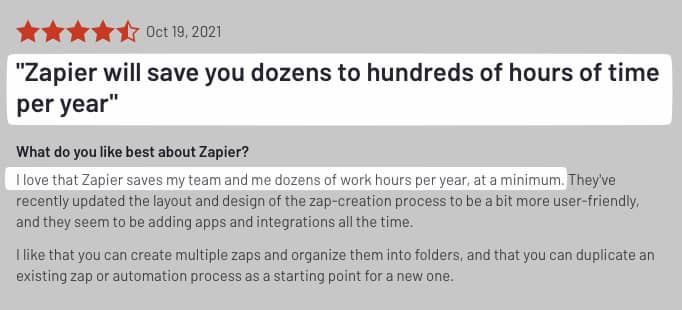
Real stories like this show other buyers who want to increase efficiency that Zapier can deliver the desired results, making them likelier to buy and willing to spend more.
Recommended reading

Customer centricity: how putting buyers first boosts business
How to implement outcome-based selling
Adopting outcome-based selling requires realigning your entire sales strategy to deliver accurate, measurable results for your customers.
Here’s a step-by-step guide to help you get started.
Step 1. Understand your customers in detail
You can’t sell outcomes without understanding your customers’ challenges and goals.
After all, you must promote the most desirable outcomes for your target audience to maximize your product’s appeal and secure sales.
Dig into your customers’ current business goals and expectations by:
-
Conducting thorough research. Gather detailed information on your customers’ industries, market trends and pain points. Use tools like market analysis reports, customer interviews and surveys, then record the insights in a CRM for easy access.
-
Creating detailed customer personas. Build comprehensive profiles representing your ideal customers, including their roles, objectives and challenges. It will help you craft targeted sales and marketing messages that meet their needs.
-
Engaging in active listening. Focus on listening more than talking during prospect interactions or interviews. Ask open-ended questions to uncover their deeper needs and desired outcomes. For example, instead of asking, “Do you need a project management tool?” ask, “What challenges are you facing in managing your projects effectively?”.
Keep seeking opportunities to collect new insights since your target audience’s goals may evolve. For example, AI wasn’t on many B2B buyers’ radars a few years ago, but most are now keen to benefit from it – how would your product address that goal?
If you continue to learn from your existing customers, you’ll be well-positioned to help new ones in the future.
Planning for different outcomes
Your audience research will likely uncover multiple outcomes to target in your sales and marketing efforts.
Building a flowchart or roadmap can help you align product qualities with the desired outcomes of different customer types and make your messaging more compelling.
Say you’re selling project management software and learn some buyers want to increase productivity (outcome 1). Others need a tool to centralize communication (outcome 2).
To ensure you cater to these objectives, build a flowchart or roadmap that aligns your product’s features with each desired outcome.
Here’s an outcome-based planning example that proved popular on Medium:
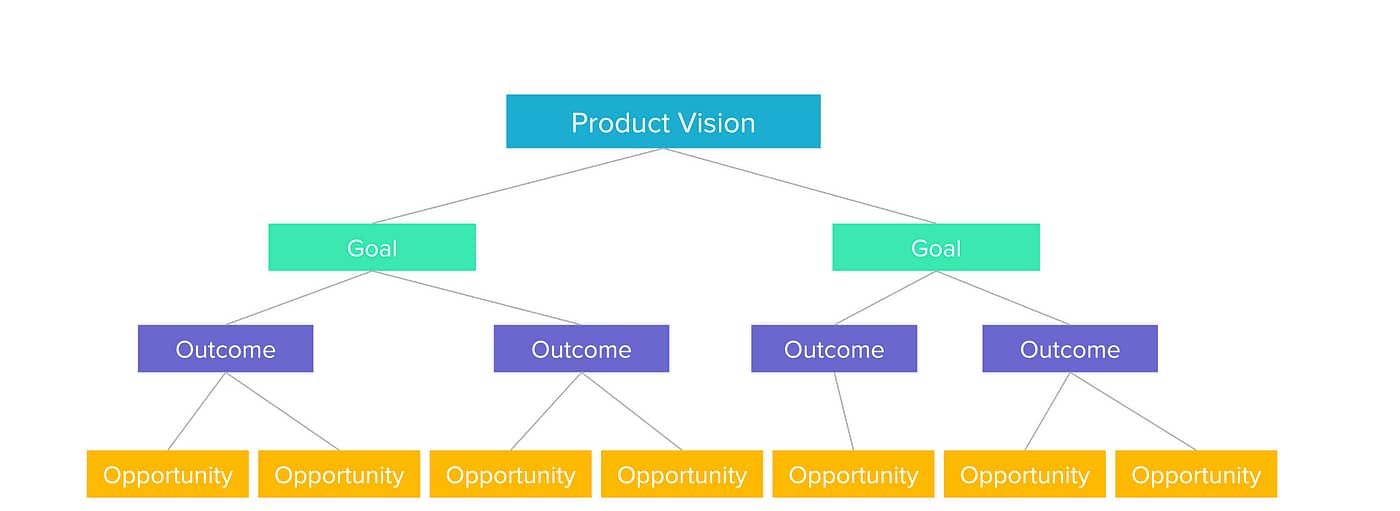
Your flowchart may be simpler or more complex, but this example gives a general idea of what the result will look like.
Step 2. Tailor your sales and marketing efforts accordingly
Once you understand your customers, the next step is tailoring your sales and marketing efforts to align with their desired outcomes.
Outcome-based marketing content
Use your company’s marketing content to showcase the results your product delivers.
Sometimes that means making broad claims, like “Our product will help you achieve [highly relevant outcome]”. Other times, it’ll involve telling authentic stories that support your value proposition – for example, “Here’s how our product helped [client] achieve [outcome]”.
Either way, you can speak directly to your ideal customers’ goals in most forms of content marketing, including:
Take this simple search ad from the virtual assistant service Moneypenny:
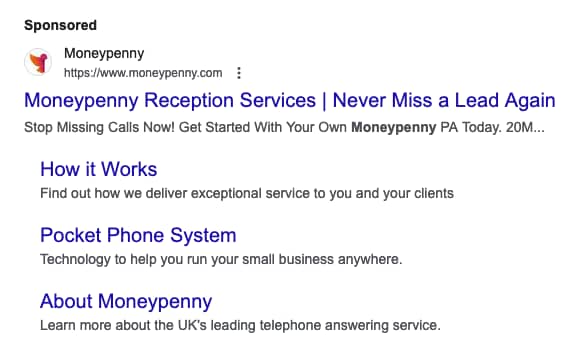
The headline reads “Never Miss a Lead Again” – a highly desirable outcome for business owners and sales organizations (the brand’s target audience). It’s likely to drive traffic to Moneypenny’s website, generating valuable leads for the sales team to nurture.
Outcome-based sales pitches
If you’re leading a sales team, equip your reps with the knowledge and tools to personalize their pitches.
Case studies work well as sales enablement content because they help sales professionals:
-
Learn which outcomes are the most desirable
-
Support pitches with tangible, reassuring evidence
You might also build outcome-focused cold email templates and cold-calling scripts to speed up your team’s outreach.
For example:
Boost Your Team’s Productivity with [Your Product Name]
Hi [Recipient Name],
Are you looking to enhance your team’s efficiency and streamline operations?
[Your Product Name] has helped companies like [Client Name] achieve a 30% increase in productivity within just three months.
Let’s schedule a quick call to discuss how we can deliver similar results for your team.
Best,
[Your Name]
If you’re a sales rep, build your pitches and proposals around outcomes you know your product helped existing customers achieve.
Share customer success stories with your peers to understand how your product benefits its target audience. Store new insights in your CRM for easy, shared access.
Download the Ultimate Sales Process Guide
Learn how to use an activity-based selling model to simplify sales and help your team scale.
Step 3. Build a library of social proof to demonstrate outcomes
Social proof is a powerful tool in outcome-based selling. Showing potential customers the success others achieved with your product builds credibility and trust. It’ll also help people who are new to your brand take your value proposition more seriously.
Over half (53%) of B2B marketers told the Content Marketing Institute (CMI) that case studies and customer stories deliver some of their best results – suggesting they’re more effective than videos and short articles.
Here are three forms of social proof to support outcome-based selling:
|
Case studies and customer stories |
Craft detailed case studies highlighting tangible outcomes you’ve achieved for clients, including specific metrics your audience will relate to (i.e., their likely key performance indicators or KPIs). For example, if you sell marketing automation software, a case study could show how a client increased their lead conversion rate by 50%. The key themes to cover in your case study are client background, initial challenges, your solution and the results. |
| Testimonials |
Testimonials are short quotes about your product or service from happy customers. You can feature them in website content, marketing materials and presentations. Make sure these testimonials focus on the outcomes achieved, like improved efficiency or cost savings. For example, a user of your marketing automation software might write something like: “We’ve saved countless hours since adopting [software name] last year. It’s allowed our team to focus on delivering better customer experiences.” |
| Third-party reviews |
Positive reviews highlighting your product’s tangible benefits and outcomes can significantly influence potential buyers. Encourage your customers to leave reviews on platforms relevant to your industry and showcase them on your website and in marketing collateral. For example, share a link to the Google Reviews platform with your happiest customers and encourage them to describe their positive experiences. |
Tracking customer sentiment will make it easier to build a library of social proof. When you can see which clients are happiest with their outcomes, you’ll know who to approach for positive feedback that you can use as marketing content.
Pipedrive helps you gauge lead and customer sentiment by analyzing email interactions using AI. The AI email summary shows sentiment alongside a readiness-to-buy score (1–10) and recommended action items.
Step 4. Follow up with customers to understand their experiences
Contact customers to understand their experiences and the results they’ve achieved.
Doing this shows you care about your customers’ success and provides valuable insights to refine your outcome-based selling approach.
Engage in regular check-ins and conduct surveys or interviews to gather feedback on the following aspects:
-
Satisfaction with outcomes. Are the customers achieving the desired outcomes they expected from your product or service?
-
Challenges faced. Have they encountered any issues or challenges in using your product that need addressing?
-
Suggestions for improvement. Do they have any suggestions on how to improve your product or service to better meet their needs?
Maintaining an open line of communication ensures your customers feel supported and valued, leading to higher customer retention and loyalty.
You can use the findings to build social proof when your product has met or exceeded expectations.
If the same problems or suggestions keep coming up in your conversations, you can credit fixes and updates to your customers, as Valora does in this LinkedIn post:
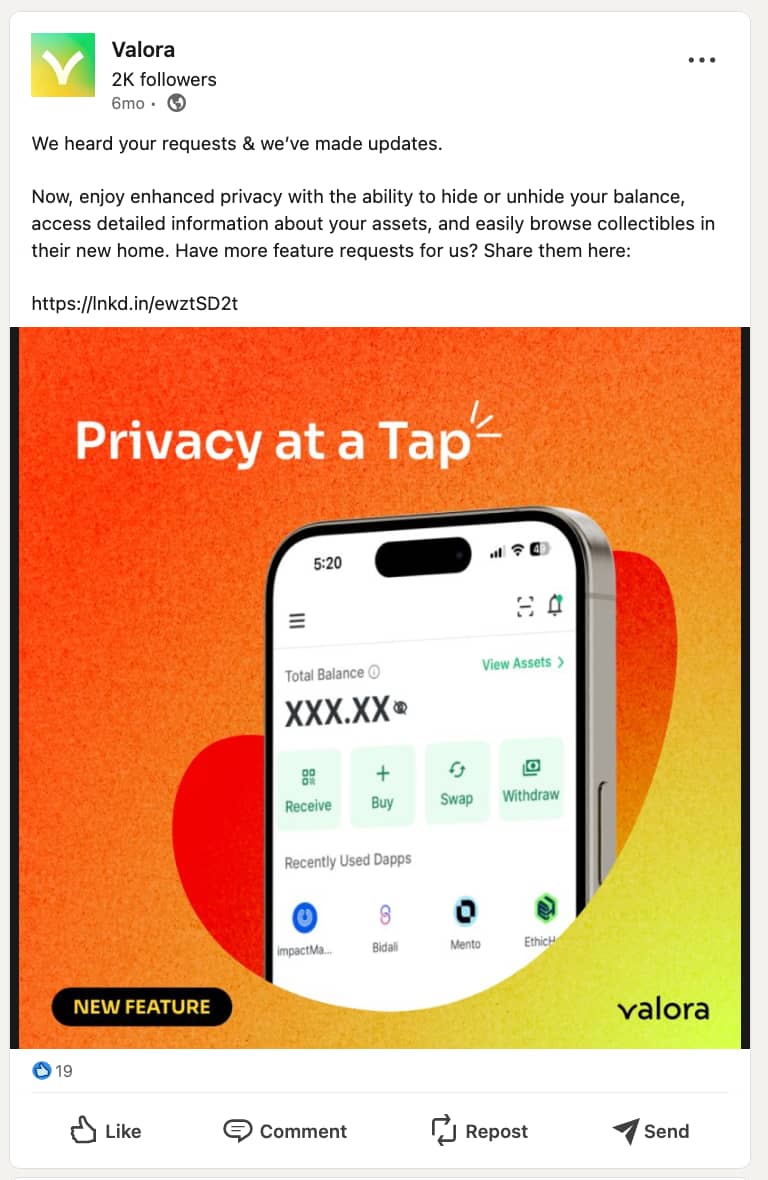
It’s a great way to turn minor dissatisfaction into a demonstration of your customer-centricity, impressing other followers.
Step 5. Build a feedback loop
Customer support and success teams that interact with customers daily are well-positioned to gather insights about customer objectives and outcomes.
Use these insights to tailor your sales and marketing efforts, making attracting, qualifying and nurturing leads easier.
Say your marketing software’s support team gets many inquiries about data privacy. Minimizing risk is desirable for existing users and emphasizing your tool’s security features to prospects will likely influence buying decisions.
Help valuable insights flow across your business by encouraging teams to:
-
Document customer interactions. Use a CRM or spreadsheet to keep detailed records of customer interactions, including common questions, concerns and feedback about the product’s performance.
-
Share insights. Arrange regular meetings or communication channels where teams can share observations and insights with the rest of the company.
-
Collaborate on solutions. Work with other departments, such as product development and marketing, to address issues and implement outcome-based customer feedback into your offerings.
Customer needs and objectives evolve constantly. Ensure your sales strategy remains dynamic and responsive with a culture of open communication and collaboration.
Step 6. Monitor the impact of outcome-based selling with a sales CRM
Analyze sales performance before and after adopting outcome-based selling to see your hard work’s results.
You’ll need a sales analytics tool. A sales CRM with customizable dashboards and reports makes tracking the metrics that matter most to you (i.e., your KPIs) easier.
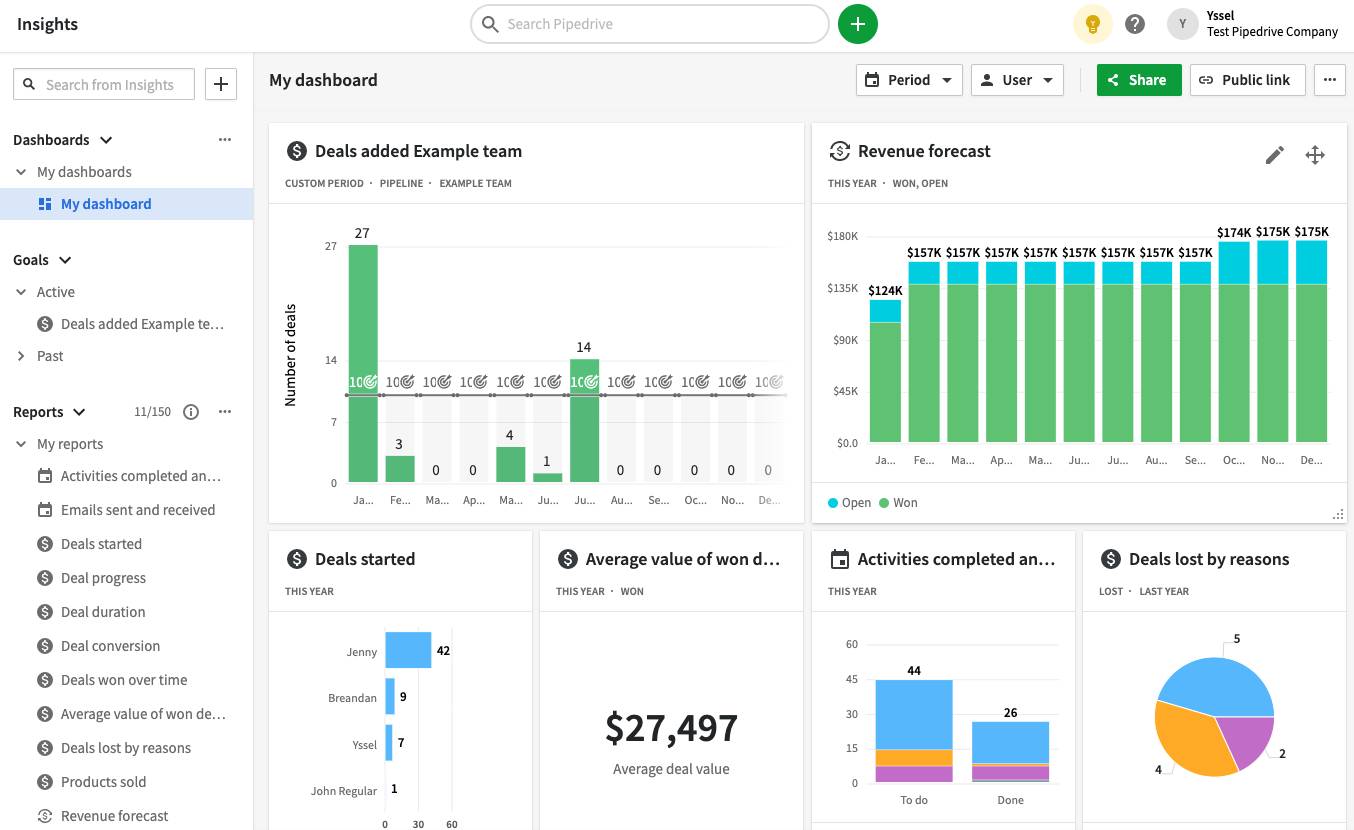
With more customers achieving their desired outcomes thanks to your product, you’ll likely see some or all of the following sales metrics rise:
If the results aren’t what you expected, gather more feedback and adjust your sales strategy to fit customer expectations.
For example, if your referral rate doesn’t increase, look for more opportunities to ask for referrals. You could include a note and link in your email signature or implement a referral scheme to incentivize customers.
If you aren’t closing more deals, it could be because the new approach has encouraged you to focus on higher-value deals with better-fit customers – another win that will still help company revenue in the long term.
Recommended reading

Craft an ideal customer profile to identify your best customers
3 tips for selling outcomes successfully
Effective outcome-based selling takes practice, but you can hit the ground running with these key takeaways.
1. Position yourself as a peer
Approach your customers not just as a salesperson but as a trusted advisor who understands their challenges and wants to address them.
A consultative approach like this builds credibility and fosters a collaborative relationship where you’re invested in customer success.
2. Keep asking questions
Ask insightful questions to uncover deeper customer needs, preferences and pain points.
This approach shows interest and attentiveness while giving you critical information to tailor recommendations and demonstrate your solution’s relevance.
3. Collect as much tangible evidence as possible
Collect hard evidence supporting your outcome-based sales efforts. It will separate you from other salespeople and companies that make lofty, unsubstantiated claims.
Customer success and account management teams collect performance data as part of their work, so see what’s already available before speaking to clients.
Recommended reading

How to collect and share compelling customer stories [with examples]
Outcome-based selling FAQs
Recommended reading

Solution Selling: The comprehensive guide
Final thoughts
Putting customer outcomes at the heart of your sales efforts helps prospects see your business’s true value. It fosters confidence, making closing deals and relationship-building much easier.
After switching from a traditional selling strategy emphasizing product features, you’ll notice benefits like a shorter sales cycle, faster revenue growth and a happier customer base.
Keep updating your knowledge by researching clients’ needs, tracking sentiment and recording the results in a CRM like Pipedrive.
If Pipedrive is of interest and you'd like more information, please do make contact or take a look in more detail here.
Credit: Original article published here.
